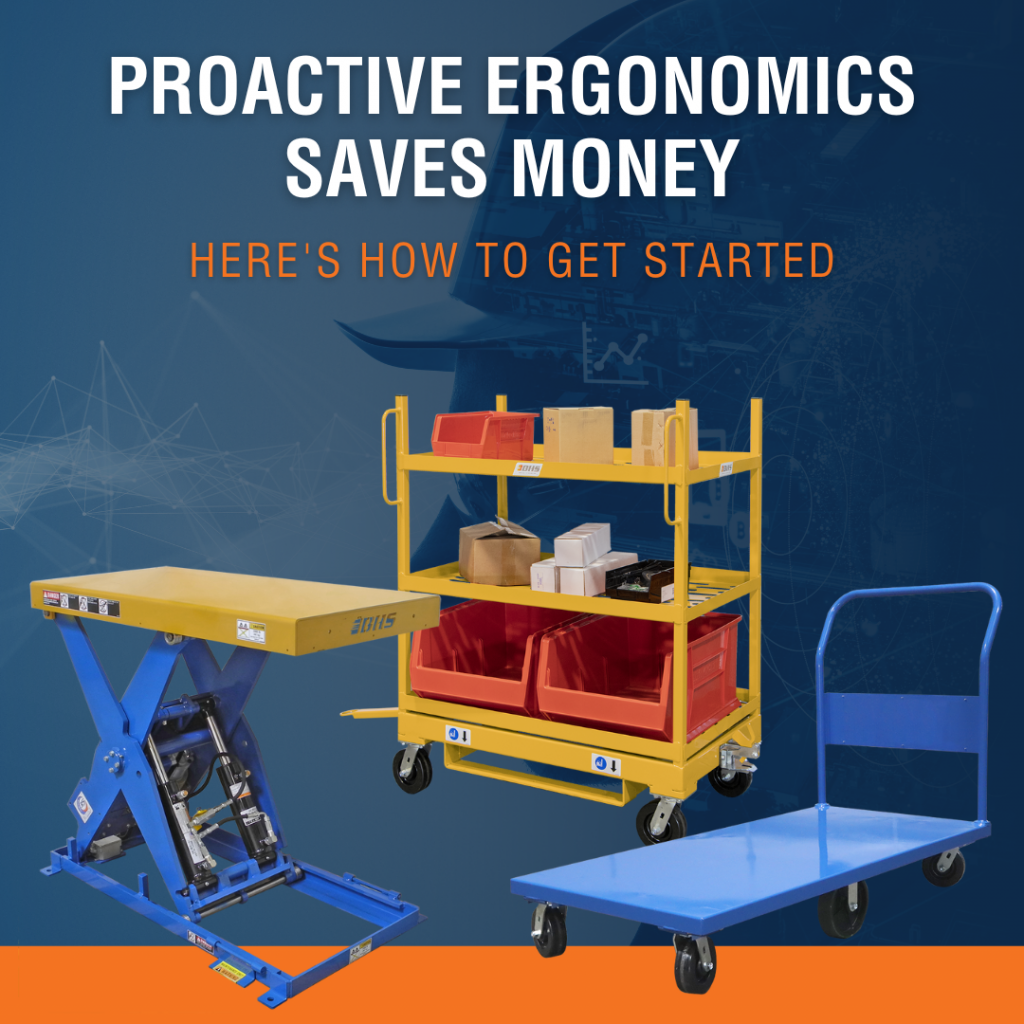We use cookies to make your experience better. To comply with the new e-Privacy directive, we need to ask for your consent to set the cookies. Learn more.
Proactive Ergonomics Saves Money; Here’s How to Get Started
Ergonomics is the science of matching the work to the worker. That involves adjusting workplace tasks, equipment, and facilities to keep employees safe and comfortable. We’ve covered the topic extensively in our blog, and while we often point out the safety benefits — appropriate ergonomics reduces the risk of common workplace injuries — there’s another reason smart business owners invest in ergonomics: It saves money. 
To get the biggest bottom-line benefits from your ergonomics program, you can’t react after injuries occur. You have to plan for prevention. This approach to workplace safety is called proactive ergonomics, and it’s a crucial best practice for workplace safety and overall productivity. Here’s how proactive ergonomics can save your business cash, plus a few tips for building your ergonomics program from scratch.
How Proactive Ergonomics Saves Companies Money
Musculoskeletal disorders are injuries to muscles and soft tissues that accumulate over time, usually due to repetition, overexertion, and awkward positions at work. These injuries made up 30 percent of all workplace injuries involving days away from work in 2018, making them a leading cause of injury-related absence. The manufacturing, warehousing, and construction industries were among the top-five producers of these MSD-related absences that year.
Ergonomics is the best way to prevent musculoskeletal disorders. In fact, the solution is so associated with these hazards that musculoskeletal disorders are also called ergonomic injuries. And there’s a clear connection between workplace injury and company spending — but injury prevention is just one of the ways ergonomics pays off.
Proactive ergonomics cuts costs in a variety of ways, including:
1. Preventing Injuries, Absences, and Worker’s Compensation Claims
How much do musculoskeletal disorders cost employers? According to the Occupational Safety and Health Administration (OSHA), worker’s compensation pays an average of over $30,000 for every instance of work-induced carpal tunnel syndrome. Sprains and strains tally up payments of $30,487 and $32,023 respectively.
Worker’s compensation insurers pass these fees onto companies in the form of higher premiums. But employers pay hefty indirect costs for these injuries, too. Here are just a few of the indirect workplace injury costs OSHA warns about:
- Additional wages above worker’s compensation payments for long absences
- Overtime payments to cover injured-worker absences
- Administrative costs for filing injury paperwork
- Training costs for replacing an injured worker
- Potential OSHA fines or legal costs
In short, ergonomic injuries are expensive. An investment in ergonomics often provides a return with the first prevented injury.
2. Improving Workplace Productivity
Ergonomics and productivity go hand in hand, which makes sense when you think about it: Comfortable workers are better able to perform their tasks. And many of the ergonomic interventions that protect workers also improve productivity.
Material handling carts remove the strain from muscles, but they also allow a single worker to perform tasks that would otherwise take a team. Variable-height workstations prevent the stretching and reaching that, over time, can impact production rates. As part of a proactive ergonomics strategy, investments in safety can double as productivity multipliers.
3. Reducing Turnover and Associated Recruiting Costs
Ergonomics doesn’t just prevent injuries; it also makes work more comfortable. Comfortable workers are less likely to leave. By creating a safer, more worker-friendly environment, you can improve workforce morale and reduce turnover rates — and that can have a positive impact on your bottom line.
According to one text on human resource management, turnover costs include:
- Spending on recruitment efforts
- Administrative costs
- Training costs
- Productivity losses as coworkers devote time to helping new workers
- Lost productivity while positions remain unfilled
These costs add up to somewhere between 25 percent and 200 percent of an employee’s salary. One analysis suggests that replacing a low-paid employee ($8/hour) can cost employers up to $4,000.
In short, it’s more cost-effective to keep workers from leaving in the first place. Proactive ergonomics can help with that effort. So how do you get started?
Starting a Proactive Ergonomics Program at Your Facility
Proactive ergonomics starts with spotting hazardous workplace conditions before they result in an injury. Conduct an ergonomics audit by observing work within your facility. Watch for:
- Repetitive tasks
- Awkward postures
- Continuous vibration
- Heavy lifting, pushing, or pulling
- Stretching, reaching, and bending
Follow your observations with interviews. Talk to employees and managers to see if there are particular tasks that cause discomfort. Compile a list of ergonomic hazards — particular tasks that include risk factors like those listed above.
Next, plan your intervention. If employees face repetitive tasks, consider cross-training them, and switch out workstations at regular intervals throughout the day. Then provide material handling equipment to eliminate overexertion and awkward movements. Here are just a few examples of tool-based interventions that support a proactive ergonomics plan:
- Install Scissor Lift Tables so workers can position work close to the body, at a comfortable height.
- Use Tilt Tables to allow employees to move loads closer to them, rather than having to reach.
- Provide specialized Material Carts, matched to workplace loads, to reduce lifting and carrying.
- Replace heavy lifting with Cranes and Booms.
- Prevent the ergonomically risky task of emptying waste bins with a Bin Dumper.
Of course, these are just a few suggestions, and true proactive ergonomics requires a plan specially tailored to unique workplace tasks. Call the BHS Sales Team at 1.800.BHS.9500 to discuss your material handling challenges, and start using proactive ergonomics to cut costs today.
